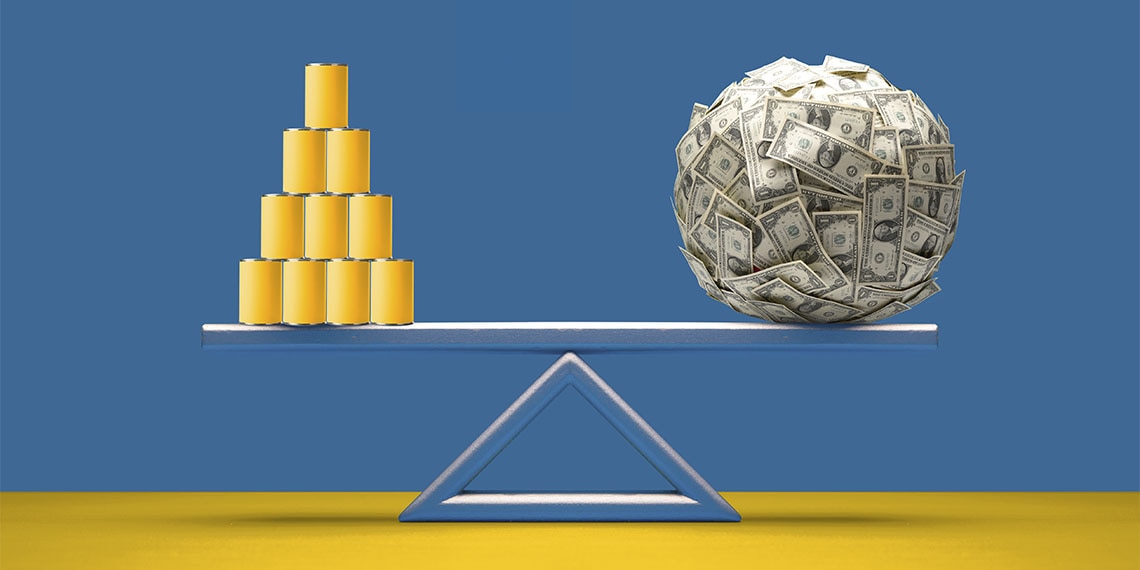
You’re out of shampoo—what do you do? Hop online, order from a retailer and pay shipping to get it to your home as fast as possible? While it may seem quick and easy, in that scenario, your budget can take a real hit. What if instead you applied the same long-term thinking strategies you use for investing and saving for financial goals to shopping for your household needs?
Thinking about your consumption over time—in three-, six- or even 12-month intervals—can help you plan your everyday shopping in order to take advantage of the best deals, from using coupons to buying in bulk.
Of course, long-term thinking in any form isn’t easy, especially when there are multiple demands on your money. “It can be difficult focusing on the long term when there is so much to think about in the short term,” says Piper Terrett, author of “The Frugal Life: How to Spend Less and Live More.” “But doing so helps you achieve your goals, because you can plan ahead.”
That’s where buying in bulk comes in: By planning your purchases ahead of time and getting the best price, you maximize your buying power, trim your budget and keep your money where it belongs—building toward your long-term goals.
How to Determine Unit Price—and Why It Matters
Buying in bulk has a couple of major advantages. One is the convenience of having commonly used items on hand. “It means you can store up items that you use regularly and you're not paying through the nose by just buying them when you need them,” Terrett says. Then there’s the money you typically save on the unit price when buying in large quantities.
What is the unit price? It’s how much you pay for a measurable quantity of an item, whether that’s determined by weight or volume. To determine it, simply divide the cost by quantity. For example, let’s say your grocery store has a seven-ounce bottle and a 15-ounce bottle of the same olive oil. Obviously, the 15-ounce bottle will have a higher total cost. But if you compare cost per ounce between the two bottles, the 15-ounce bottle might come out ahead. (If you’re not used to comparing prices this way, keep in mind: We all shop by the gallon at the gas pump!)
Comparing unit price will help you find the best deal across brands, stores and retailers, whether you’re buying in bulk or not—although you’ll often see the savings in bulk.
How to Buy in Bulk
Employ a few essential bulk-buying strategies to make sure your money is being well spent. “The key is to buy stuff you actually use in bulk,” Terrett says. “Buy-one, get-one-free deals can be tempting in stores because you think you're getting a great deal, but it's no good if it's things you don't use regularly or really want—as it's just a waste of money, and your cupboards will be full.”
First, track your consumption over time for specific products you might buy in bulk, whether it’s pet food, canned goods or beauty products. You need to make sure you can use whatever you buy before it expires, both for the product’s shelf life and once it’s opened. Second, a bulk purchase is not the time to experiment with a new product. Stick to tried-and-true favorites. Third, take into account both your available storage space and storage conditions. Many pantry items and health and wellness products require a cool, dry and relatively dark location, protected from pests and mold, for optimal shelf life.
Small household? You can still take advantage of bulk prices by dividing up commonly purchased items with friends and family. Similarly, finding a group to share with can help you purchase from farm shares or other off-the-beaten-track food suppliers to get great deals. “I belong to a local food swap group, and we often share things like large orders of bread flour from a local mill,” Terrett says.
A final financial note: While it's great to get a bargain, keep in mind how much cash you’ll have tied up in your pantry, cupboards or closet. Can you still afford to supplement those dry goods bought at bargain prices, for example, with all the fresh groceries you’ll need over the next six months to a year?
What to Buy—and Not Buy—in Bulk
There are no hard-and-fast rules about what to buy or not buy in bulk—after all, if you need and can use a large quantity, any purchase makes sense. But make sure to consider both unit price and shelf life before you buy. Anything you don’t use is just money down the drain.
Some good contenders for bulk purchases:
● Diapers
● Shampoo and conditioner
● Toothpaste
● Soap
● Butter
● Alcohol
● Dried pasta, cereal and white rice
● Frequently used canned foods
● Pet food
● Paper towels and toilet paper (but please, no hoarding)
● Office supplies
In general, avoid:
● Sunscreen and other skincare products, which have short-term expiration dates
● Over-the-counter medications and vitamins, because they’re expensive and may expire before you can use them
● Spices, because they lose their potency over time
● Flour, nuts and whole grains such as brown rice and oatmeal, as they can go rancid in a few months or attract pests
● Bleach, as it loses efficacy in six to 12 months
● Cooking oils, as they don’t store well
● Condiments, because large containers are easily contaminated and expire quickly after opening
● Coffee, because any java snob will tell you a good cup of coffee is all about freshness. You’re already saving by making your coffee at home, so take the win!
For more ideas on shopping smarter and saving money, check out savings tips for drug stores and home improvement stores.
Julie Anne Russell is a Brooklyn-based freelance journalist. She writes about personal finance, small business, travel and more.
READ MORE: Could Shopping Offline Save You Money?

